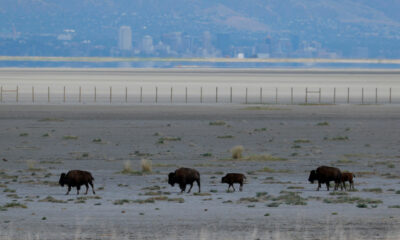Environment
Life in Time of Drought: Will Mount Shasta Bottle Its Water for Profit?

To sign up for Leighton Woodhouse’s email newsletter on the drought, go to Land of Thirst.
Nine years ago, Raven Stevens moved to Mount Shasta, California, after being priced out of the housing market in Santa Cruz, where she had lived for 27 years. She describes the picturesque mountain town just south of the Oregon border as a community “in transition.” By that she means two things: it is an economy moving from logging to more sustainable industries, such as tourism. And it is a community being overtaken by transplants from the Bay Area, like herself.
“We bring our crazy ideas with us,” she says. “And we get a hard time for that. We’ll never be locals. I’ve heard some people say, ‘You people should just go back to where you came from.’”
The house Stevens and her partner purchased in Mount Shasta is about two thousand feet south of an old water bottling plant that was vacated in 2010 by Coca-Cola/Danone. A few months from now, in the midst of the worst drought the state has ever known, the plant will begin pumping groundwater for export again, this time under the management of the Crystal Geyser Water Company.
Stevens and her neighbors, many of them also from the Bay Area, are worried about the impact the new plant will have on the aquifer their wells will share with the proposed pumping and bottling operation. In addition to groundwater depletion, Stevens and others are concerned about the risk of contamination of the aquifer, which is at the headwaters of the Sacramento River. The plant plans to discharge its contaminated wastewater, which it claims will be “well within all applicable standards for drinking water quality,” in a leach field, which will percolate into the ground.
“The soil here is very porous,” Stevens tells Capital & Main. “And the leach field water goes right down into the aquifer, very quickly. It runs anywhere from six to 20 inches an hour.”
“The effluent from Crystal Geyser is an industrial waste discharge that the regulators do not require to be treated,” says Robert Blankenship, an environmental management consultant who has reviewed the compliance reports submitted on behalf of Coca-Cola/Danone when it owned the facility. “The chemical that has been found beneath the leach field is DEHP or bis(2-ethylhexyl) phthalate, which the EPA notes can cause early onset menopause in women. DEHP has been found adjacent to the Crystal Geyser leach field in a quantity about 40 times the maximum contaminant level in drinking water.” The state water board will only require the plant to test the groundwater for pollution once a year.
In response to Capital & Main‘s request for comments on these and other allegations, Crystal Geyser emailed a statement that read, in part:
There have been numerous independent studies and tests conducted by many credible engineering and hydrogeological firms and all have concluded that the restart of the existing facility will have negligible effect on the local environment. We anticipate that once the first line is fully running, the Mt. Shasta water bottling plant will use less than one percent of the total average daily water production of Big Springs, one of several springs in the Mt. Shasta area.
Stevens says the concern she and other Bay Area transplants have about water conservation is one of the many things that set them apart from the town’s old-timers. “The mindset has always been that we’re water rich,’” she says. Stevens recalls the response to when she and her neighbors have complained about the risk of groundwater depletion from the new plant. “Basically what we’ve been told is, ‘Well that’s your problem. You’ve got to dig a deeper well.’”
Instead of digging, Stevens and her allies are demanding that an environmental impact report (EIR) be prepared for the new plant. They dispute Crystal Geyser’s assurances that its groundwater pumping will cause no drop in the level of the water table.
“The science in their reports was completely inadequate,” says Dan Axelrod, a retired University of Michigan physics professor who lives about five miles from the plant site. Axelrod contends that the water bottler’s claims are based on its estimated impact to a spring that may not even be connected to the aquifer in question.
Siskiyou County argues that an EIR is unnecessary. The site was already used for bottling, it contends, so the new plant does not represent a change from past practice. “My job as a supervisor is not to regulate, but to make sure that they follow the process,” says Siskiyou County Supervisor Ed Valenzuela. “They were asking for a full EIR when it was not required. It would be a different story if it were a brand new project.”
To many Californians, the idea of erecting a new facility to export groundwater out of state during a drought may seem beyond paradoxical.
“Millions of us are doing our part to help preserve this vital resource,” says Eddie Kurtz, Executive Director of the Courage Campaign, a California-based advocacy group that has been mobilizing its members to stop companies from bottling and selling dwindling reserves of California groundwater. “
.” At least one water bottler agrees: last week Starbucks announced that, due to the water shortage, it was moving the company’s Ethos Water bottling operations from Merced, in the Central Valley, to Pennsylvania.
In Valenzuela’s view, however, the drought is part of the reason the local community needs the new plant. With no snow on iconic Mount Shasta itself, the local ski park was closed all of last season, putting two restaurants out of business and taking a toll on local hotels. The community needs the new taxes that the plant will furnish, and the new jobs it will produce — 40 of them, according to Mayor Geoff Harkness, in the $50,000 salary range, with benefits. Even if a number of those positions are filled by transfers from outside of Siskiyou County, Harkness and Valenzuela believe that the net benefit to the local economy will be significant.
The threat the Crystal Geyser plant poses to the subterranean water table in Siskiyou County is compounded by the likelihood of yet another water bottling facility popping up in the next few years just 16 miles down the road. In the town of McCloud, a deal is currently being worked out to build a new plant on a property that until six years ago was the site of a proposed Nestlé bottling facility, which, in the face of environmental challenges from opponents within the community, never broke ground.
Diane Lowe is one of the local residents who fought the Nestlé plant’s opening in order to protect the area’s watershed. She and her husband bought a second home in McCloud 15 years ago, while living in Marin County. “I could not believe how wonderful the water was,” she recalls. “I couldn’t believe how the water was running free and how it was so tasty.” Her husband, who was drawn to the area for its legendary fishing, set out to learn everything he could about the rivers, and taught as much of it as he could to his wife.
Lowe remembers how divided the town initially was on the proposed Nestlé operation. During the course of one community meeting on the issue, she recalls, “Some people walked out. They didn’t want to hear anybody from ‘down below’ — meaning San Francisco — tell them what to do with their water.” But by the end of that meeting, she says, many of the town’s old-timers were on her side. Six months later, the neighbor who she specifically recalls uttering the phrase about people from “down below” was on her side, too. In 2009, Nestlé pulled out of McCloud, moving its new plant to Sacramento.
The victory has turned out to be short-lived. Today, Lowe and her husband live in McCloud year-round. And once again, she finds herself on the brink of a fight over the opening of a water bottling plant on the very same site.
Last year, McCloud Partners, an investment group, purchased the old Nestlé property for $1.45 million. Now, the firm is planning to build a “boutique” water bottling plant there, under a new brand, the McCloud Artesian Spring Water Company. “They are gung ho, 100 percent water bottling,” Lowe says of McCloud Partners. “And I am really, really surprised. The majority of them are Bay Area people.”
Bruce Berlinger, a Marin County-based real estate developer who is one of McCloud Partners’ principals, declined to be interviewed. But by email, he wrote, “The economy in Siskiyou Country is struggling, with very high unemployment and very little business in the area.” He argued that the new plant will pay for local infrastructure needs that have long gone unmet. He described his development plans as reflective of “a cooperative attitude and understanding of McCloud,” and based on “thousands of pages of environmental reports on the water supply to the springs, to the creeks and the rivers.” He claimed that “the environment is certainly one of our major concerns.”
The town is, once again, split on the issue. But this time, the dividing line between old-timers and more recent arrivals from “down below” is not so neat.
“It’s really surprising that they would want to come up,” Lowe says of the Bay Area-based investors. “It just seems to go against so much of what second-home owners stand for here — the pride and caring of the natural resources and the environment. That’s what brings people here. I mean you wouldn’t move here for a second home otherwise.”
-

 The Heat 2024April 1, 2024
The Heat 2024April 1, 2024The Way-Down-the-Ballot Races That Could Transform Energy Policy for Millions
-

 California UncoveredMarch 18, 2024
California UncoveredMarch 18, 2024A California Program to Get Produce to Low-Income Families Is a Hit. Now It Is Running Out of Money.
-

 Extreme WealthApril 2, 2024
Extreme WealthApril 2, 2024Extreme Wealth Is on the Ballot This Year — Will Americans Vote to Tax the Rich?
-

 The Heat 2024March 19, 2024
The Heat 2024March 19, 2024In Deep Red Utah, Climate Concerns Are Now Motivating Candidates
-

 Latest NewsApril 3, 2024
Latest NewsApril 3, 2024Tried as an Adult at 16: California’s Laws Have Changed but Angelo Vasquez’s Sentence Has Not
-

 Latest NewsMarch 20, 2024
Latest NewsMarch 20, 2024‘Every Day the Ocean Is Eating Away at the Land’
-

 State of InequalityApril 4, 2024
State of InequalityApril 4, 2024No, the New Minimum Wage Won’t Wreck the Fast Food Industry or the Economy
-

 State of InequalityMarch 21, 2024
State of InequalityMarch 21, 2024Nurses Union Says State Watchdog Does Not Adequately Investigate Staffing Crisis



















